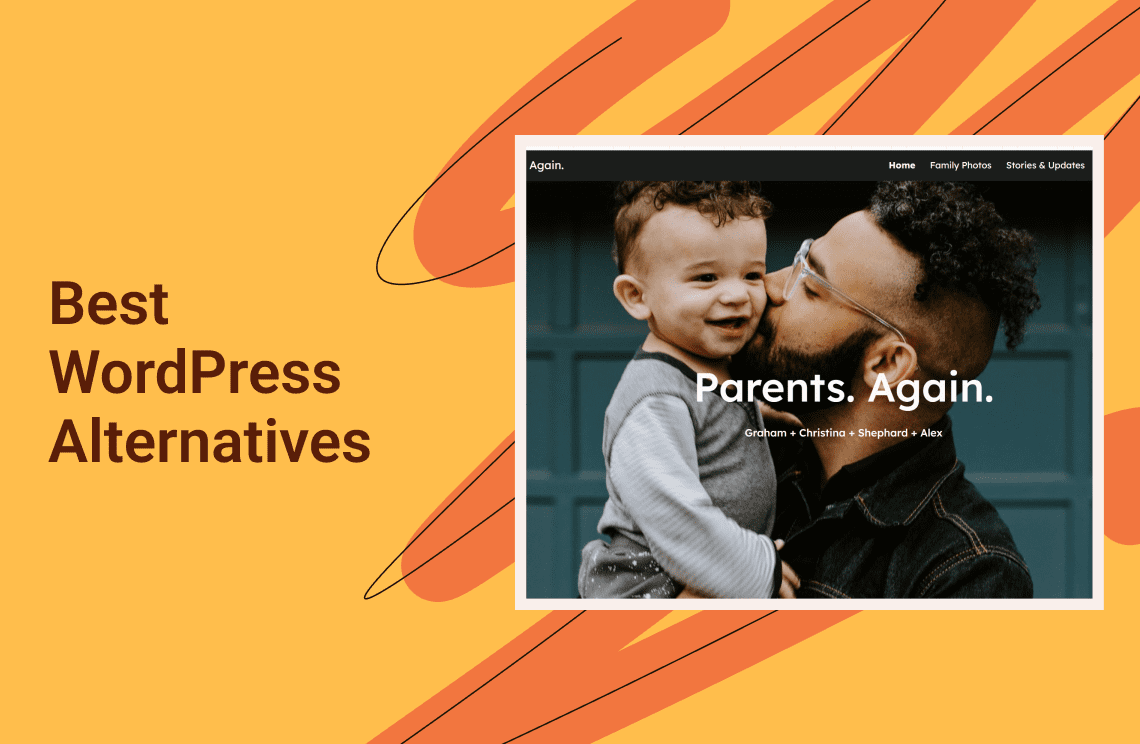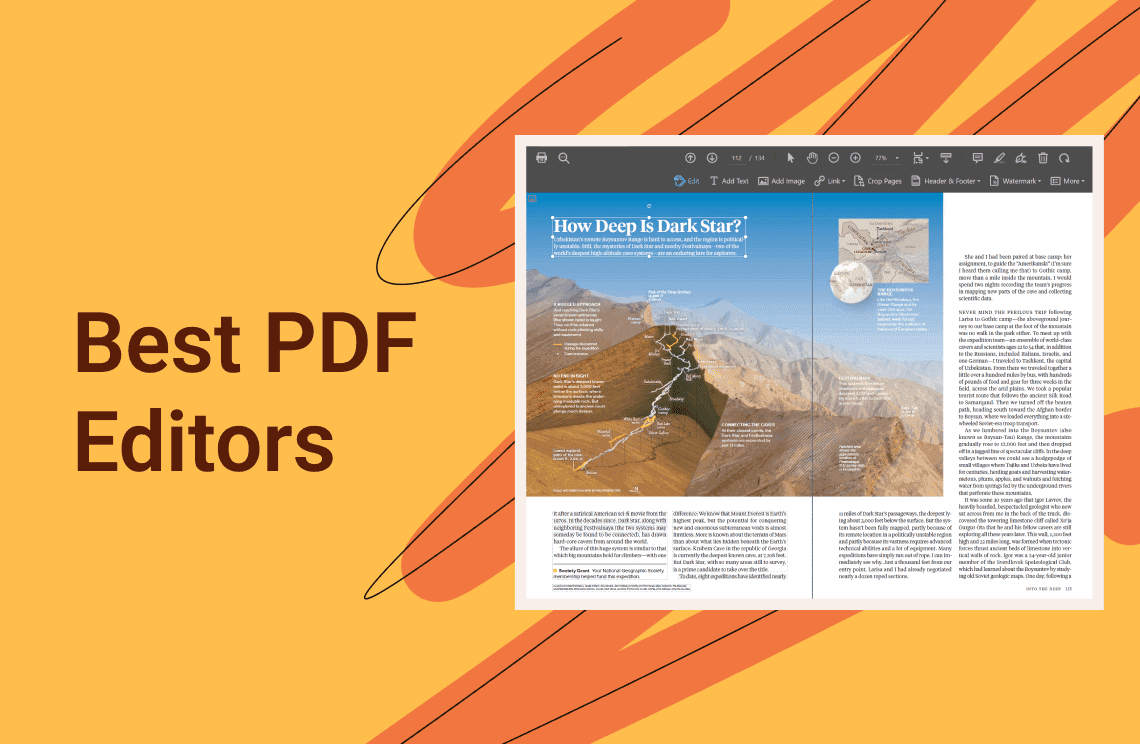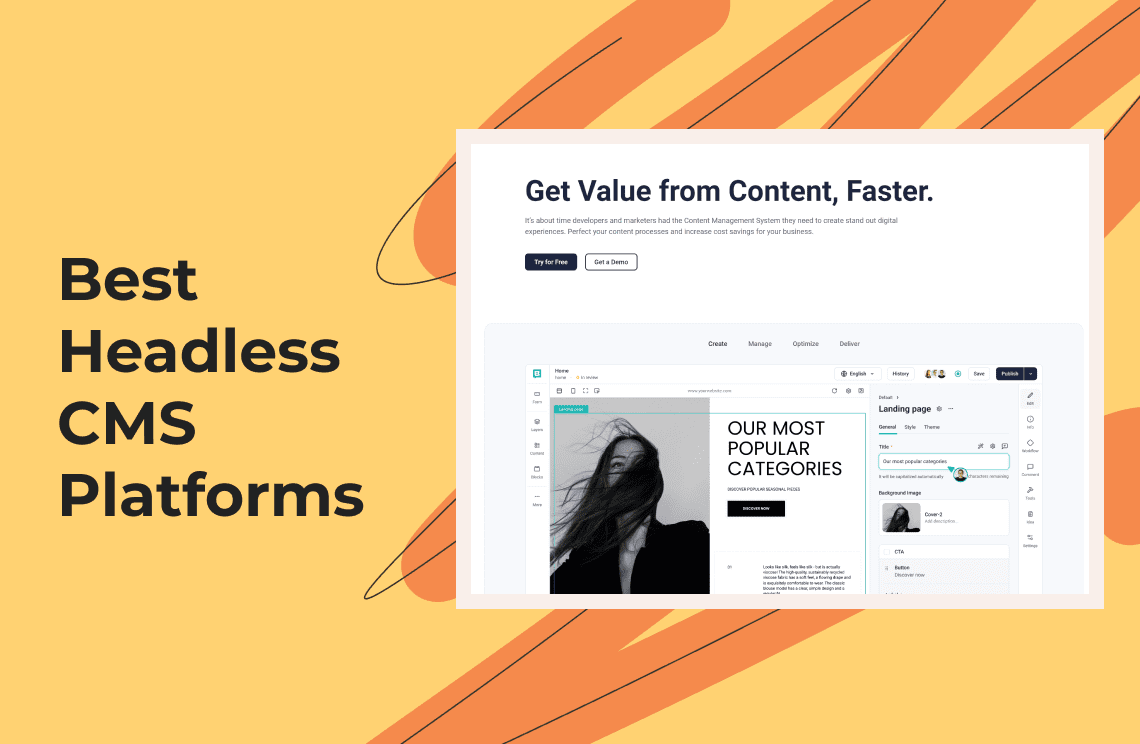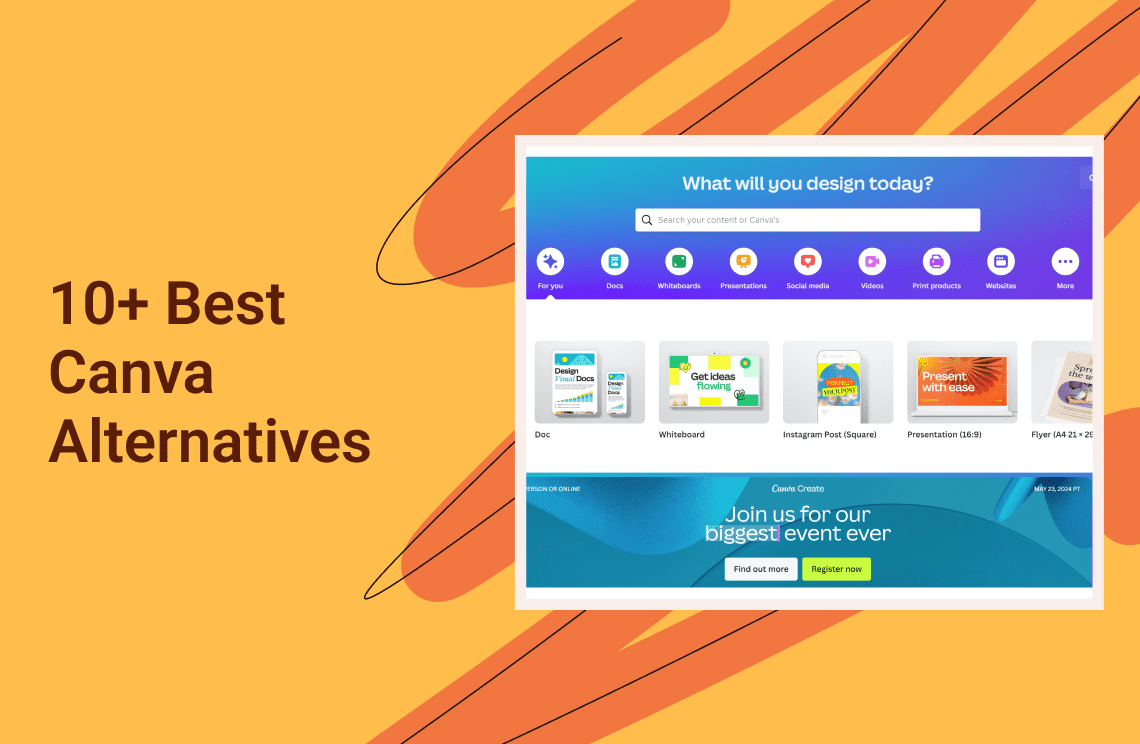The digital landscape is always evolving, and finding the right platform for creating your online presence is crucial. While WordPress stands out for its flexibility and extensive plugin system, it's not the one-size-fits-all solution for everyone. In 2025, a myriad of WordPress alternatives have emerged, offering unique features tailored to different needs. Let's dive into the best alternatives to WordPress, from a firsthand user perspective.
1. Shopify
Shopify has revolutionized the way we think about online stores. As a user who has explored multiple eCommerce platforms, I found Shopify to stand out due to its blend of simplicity and comprehensive features designed specifically for online sales, making it an attractive choice for anyone looking to start an eCommerce or mixed commerce business.

Key Features of Shopify:
- Exclusively for eCommerce or mixed commerce business: Shopify focuses primarily on providing a robust platform for online stores, including features that support brick-and-mortar operations.
- Hosted platform with maintenance and support: As a user, I didn't have to worry about the technicalities of hosting, updates, or security, as Shopify handles it all.
- Extendable with themes and apps: The platform comes with a variety of free and paid themes and apps, allowing for extensive customization and added functionality to meet specific business needs.
Pros:
- User-friendly: Shopify's intuitive interface made it easy for me to set up my store without needing a background in web development.
- Comprehensive tools for sales and marketing: The platform offers a wide range of built-in tools that support sales, marketing, and SEO efforts.
Cons:
- Transaction fees: Unless using Shopify Payments, you're subjected to additional fees on transactions, which can add up.
- Limited customization without coding: While the platform is customizable, achieving unique functionality often requires knowledge of Shopify's coding language, Liquid.
Pricing:
Basic: $25/month billed annually
Shopify: $69/month billed annually
Advanced: $299/month billed annually
2. Wix
For creatives and small business owners keen on establishing an online presence quickly and effortlessly, Wix serves as a beacon of ease and flexibility. Having tested various website builders, Wix's user-centric approach and rich template gallery significantly eased the website creation process for me.
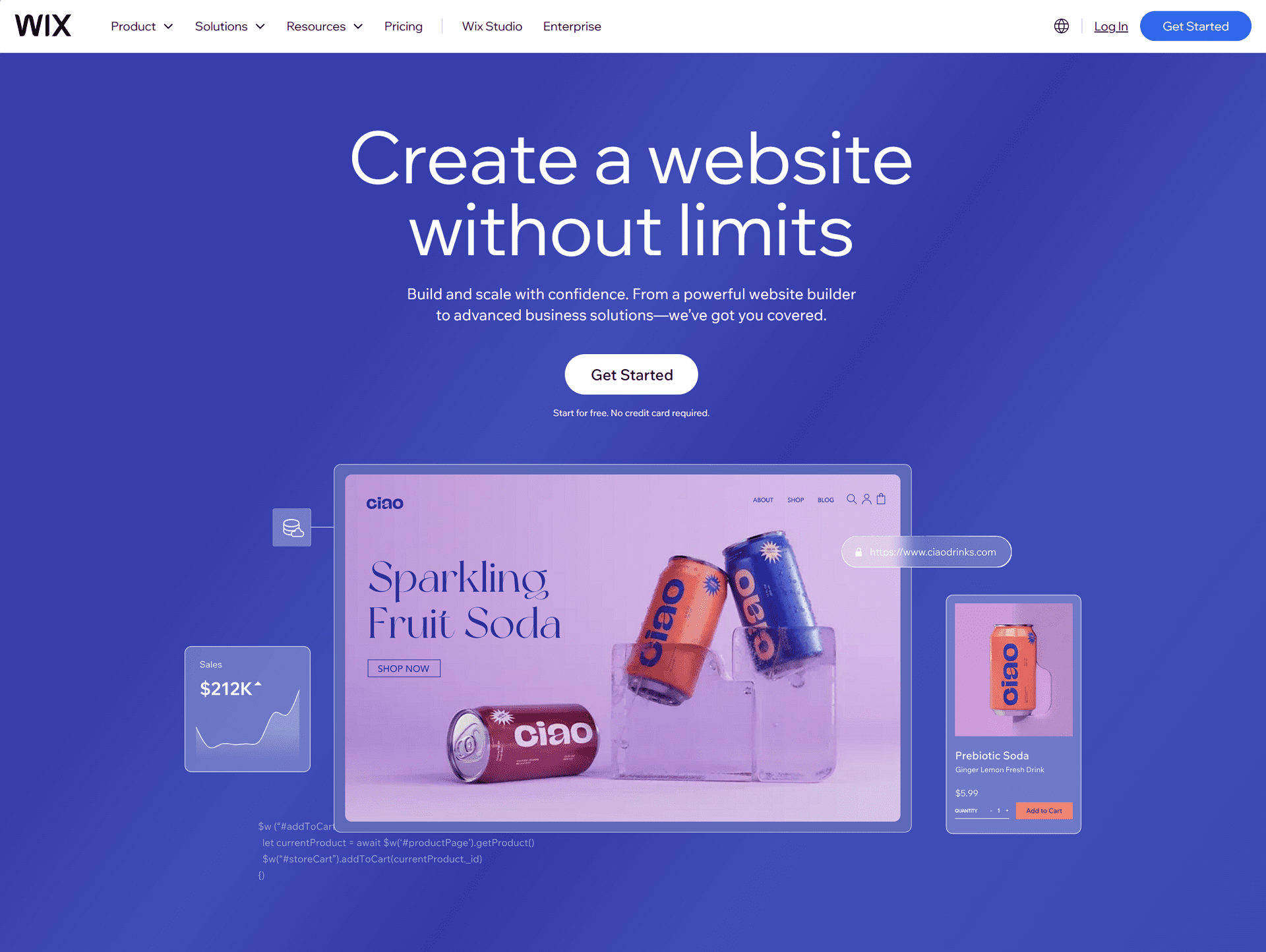
Key Features:
- Fully-hosted with no need for coding: Wix removes the hassle of website setup and maintenance, providing a fully-hosted solution that takes care of all the technical aspects.
- Extensive collection of templates: The platform offers a wide range of customizable templates that cater to different industries and styles.
- Drag-and-drop customization: Similar to moving elements in PowerPoint, I found Wix's drag-and-drop editor extremely intuitive, enabling me to design pages precisely how I imagined them.
Pros:
- Ease of use: Wix's platform is remarkably user-friendly, perfect for those without any web development experience.
- Flexibility in design: With its drag-and-drop feature, I enjoyed the freedom to customize the look and feel of my website extensively.
Cons:
- SEO limitations: While Wix has improved its SEO tools, some aspects, like URL customization, remain limited, posing challenges for advanced SEO strategies.
- Difficulty switching templates: If you decide to change your website's template after designing it, you'll have to redesign the site from scratch, which can be time-consuming.
Pricing:
Light: $17/month
Core: $29/month
Business: $36/month
Business Elite: $159/month
These platforms present viable alternatives to WordPress, each with its unique set of strengths and weaknesses, catering to different user needs and preferences. Whether it’s the comprehensive eCommerce support offered by Shopify or the design freedom facilitated by Wix, users in 2025 have rich options to choose from for creating their online presence.
3. Squarespace
Squarespace shines as a sophisticated and all-encompassing website creation tool that caters to creatives, small businesses, and personal brands aiming for elegance and functionality in their online presence. My experience with Squarespace revealed how its well-crafted templates and integrated features simplify the process of establishing a professional-looking website without external help.
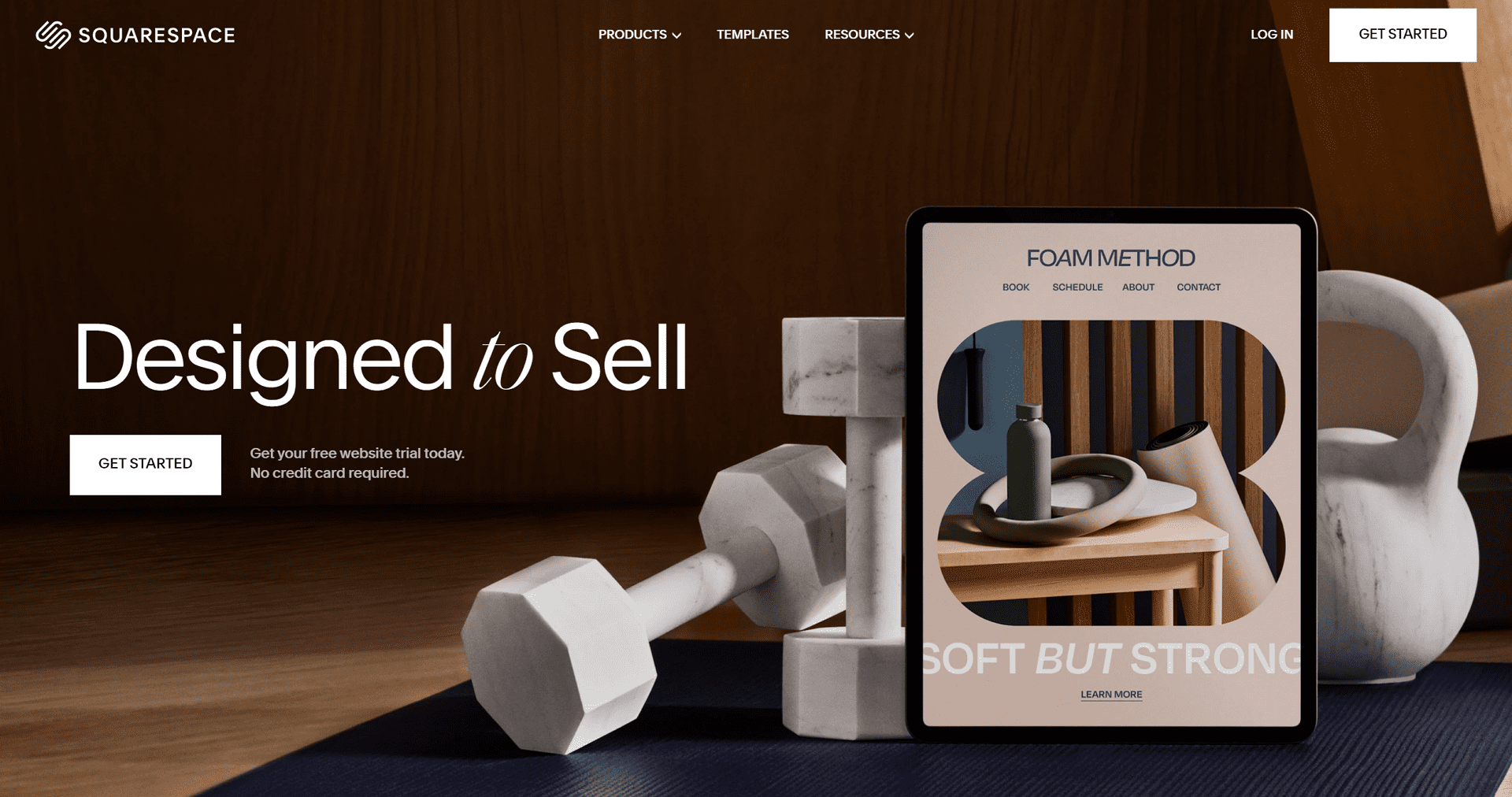
Key Features of Squarespace:
- An all-in-one solution including domain, hosting, and design: This feature greatly simplifies website management by combining all necessary services under one roof.
- Over 100 beautifully designed templates: Squarespace's templates are not only visually appealing but also responsive, ensuring that websites look great on all devices.
- Built-in SEO and marketing tools: The platform provides a suite of tools to help optimize your site for search engines and engage with your audience.
Pros:
- Ease of use: Squarespace's user interface is intuitive, making it easy for beginners to navigate and create stunning websites.
- High-quality design: The templates and design features emphasize aesthetics, ensuring that your site stands out with a professional appearance.
Cons:
- Limited customization options: While Squarespace templates are beautiful, customization options can be limited compared to other platforms, potentially hindering unique site requirements.
- Higher price point: The starting price is slightly higher, making it a consideration for those on a tight budget.
Pricing:
Personal: $16 per month
Business: $23 per month
Commerce Basic: $27 per month
Commerce Advanced: $49 per month
4. Webflow
Webflow is a groundbreaking platform that merges the visual appeal of traditional website building tools with the deep customizability and control typically reserved for custom coding. During my time exploring Webflow, I was particularly impressed by its emphasis on giving users complete design freedom while keeping the interface accessible to those without a coding background.
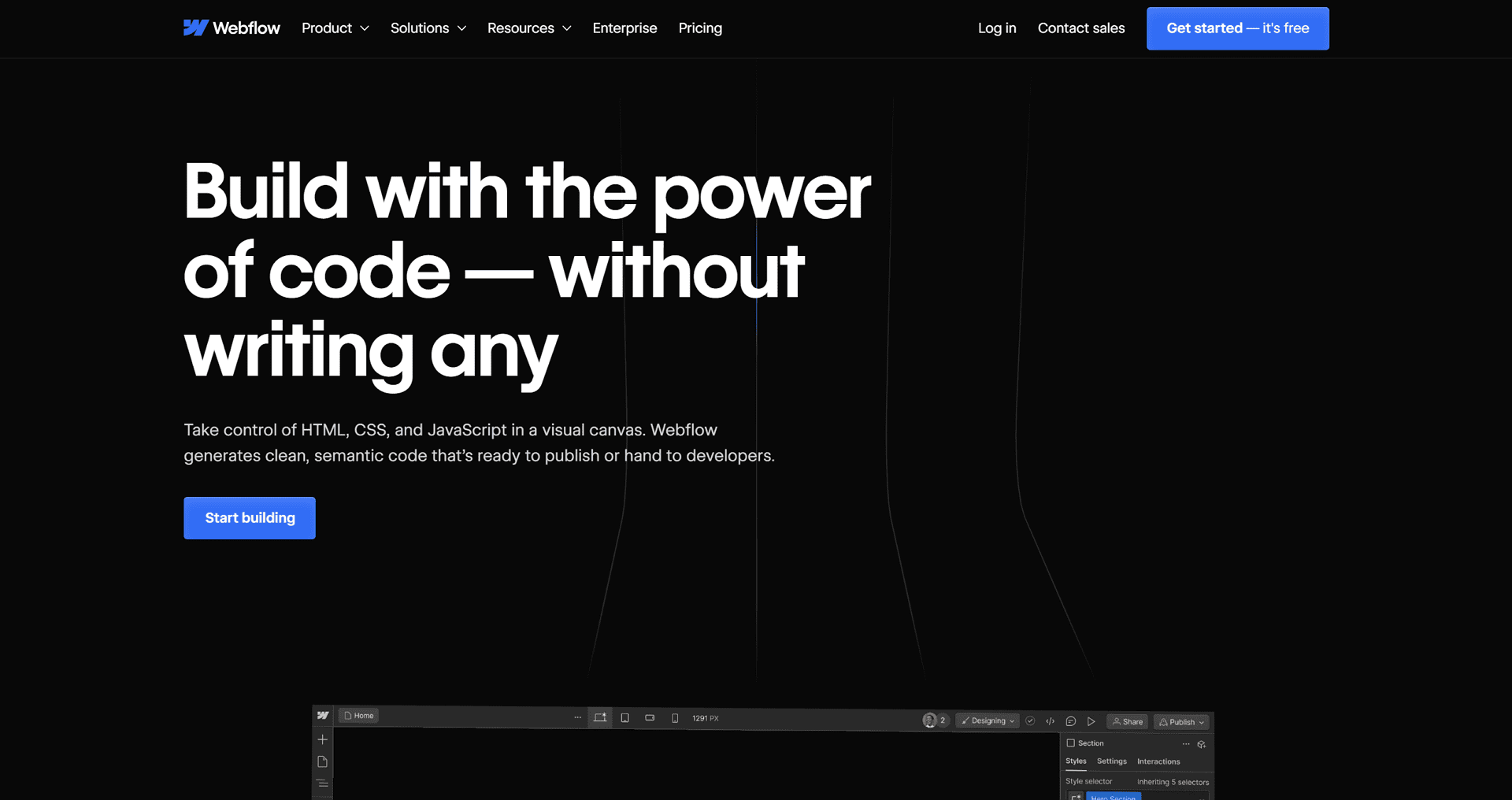
Key Features of Webflow:
- All-in-one SaaS platform with built-in features: Webflow offers a comprehensive package including hosting, security, and a content management system.
- Beginner-friendly visual site builder: The platform provides a powerful visual interface that mimics the complexity of coding through visual tools, making web design more accessible.
- Custom CMS builder for building flexible content systems: This feature allows for the creation of custom databases and dynamic content, a boon for sites requiring regular content updates like blogs or portfolios.
Pros:
- Unparalleled design flexibility: Webflow offers advanced design customization, outshining other platforms in how precisely one can control the site's look and feel.
- No-code logic and interactions: The ability to add complex interactions and animations without coding is a standout feature, empowering designers to bring their visions to life.
Cons:
- Steep learning curve: Despite being beginner-friendly, mastering Webflow’s full suite of tools can be daunting due to its depth of functionality.
- Pricing can be confusing: With various plans and hosting options, determining the best choice for your needs may require some research.
Pricing:
Free to build a test site with paid plans starting at $14/mo.
Basic (for relatively simple, static sites): $14/month billed yearly
CMS (for blogs or other content-driven sites): $23/month billed yearly
Business (for larger sites): $39/month billed yearly
Squarespace and Webflow offer compelling routes to creating websites that resonate with one's aesthetic sensibilities and functional requirements. While Squarespace prioritizes simplicity and design, catering to users who want a beautiful website without delving into the nuances of web development, Webflow provides a powerful toolkit for those seeking the utmost control over their site’s design without writing a single line of code. Each platform caters to different preferences and skill levels, underscoring the diverse array of options available beyond WordPress in 2025.
5. Duda
Duda is a web design platform geared towards agencies, freelancers, and businesses that manage multiple client websites. My experience with Duda was particularly enhanced by its focus on team collaboration and client management features, making it a standout choice for professionals looking to streamline their web design processes.
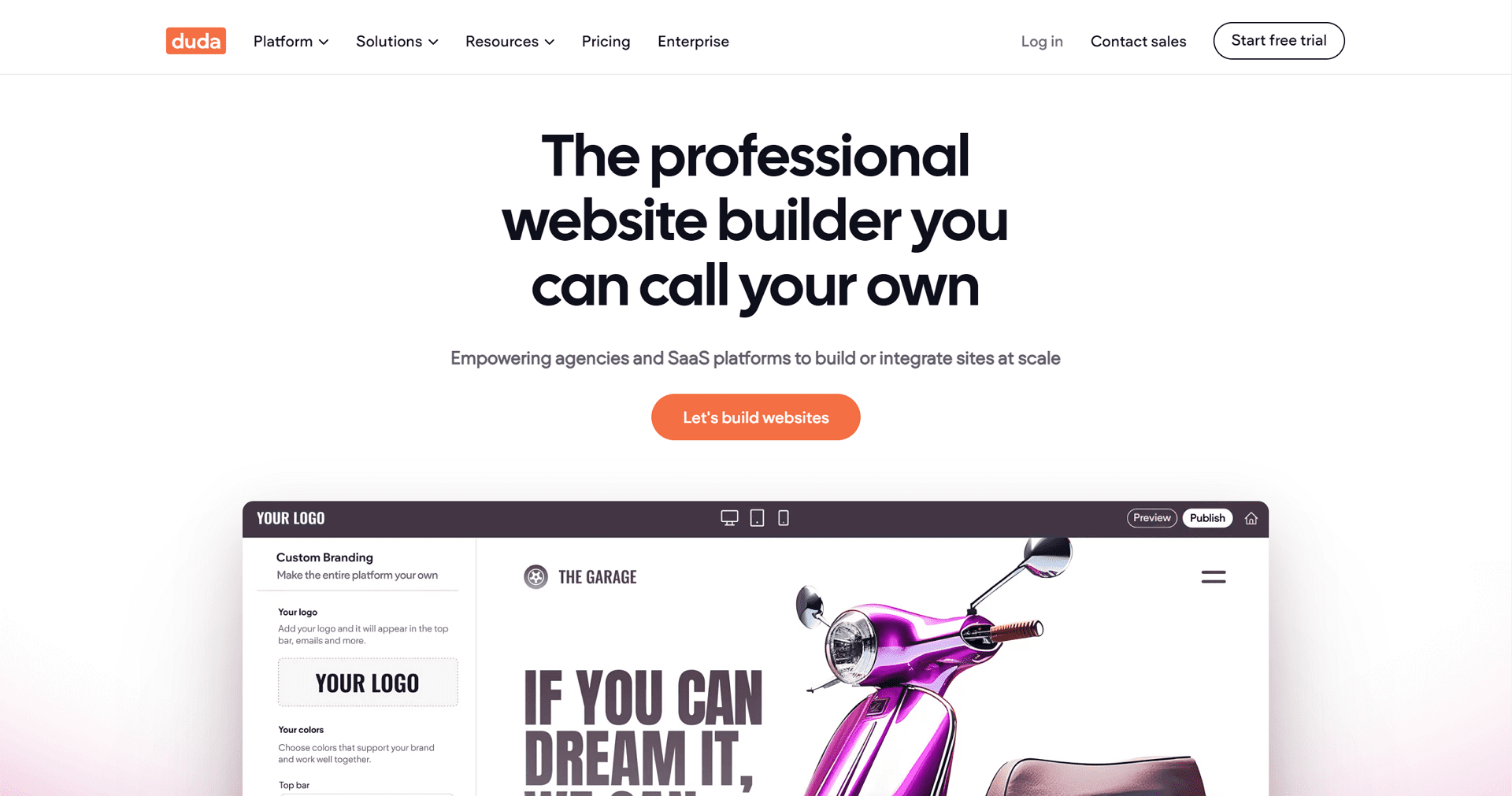
Key Features of Duda:
- Intuitive drag-and-drop interface: This makes it easy for users of all skill levels to create and customize websites without needing coding knowledge.
- Agency plans for hosting/managing client sites (with Whitelabeling): Duda offers specialized plans that include tools for managing multiple websites and client communications under your brand.
- Built-in, pre-made templates with customization options: The platform provides a range of templates that can be customized to meet specific design needs.
Pros:
- Optimized for speed and efficiency: Websites built on Duda are known for their fast loading times, boosting SEO and user experience.
- Client management features: Duda’s platform includes features like client permissions, team roles, and site comments, which are invaluable for collaborative projects.
Cons:
- Limited e-commerce capabilities: Compared to specialized e-commerce platforms, Duda's features in this area are somewhat limited, making it less ideal for complex online stores.
- Higher cost for full features: Accessing the full suite of agency-level features can become expensive, which might be a barrier for smaller operations.
Pricing:
Basic: $19/month billed annually
Team: $29/month billed annually
Agency: $52/month billed annually
White Label: $149/month billed annually
6. Drupal
Drupal is a powerful, open-source content management system that is highly favored in the world of complex, content-heavy websites and applications. As a user who has delved into the capabilities of Drupal, I appreciate its flexibility and the robust community support which fuels its expansive library of modules and themes.
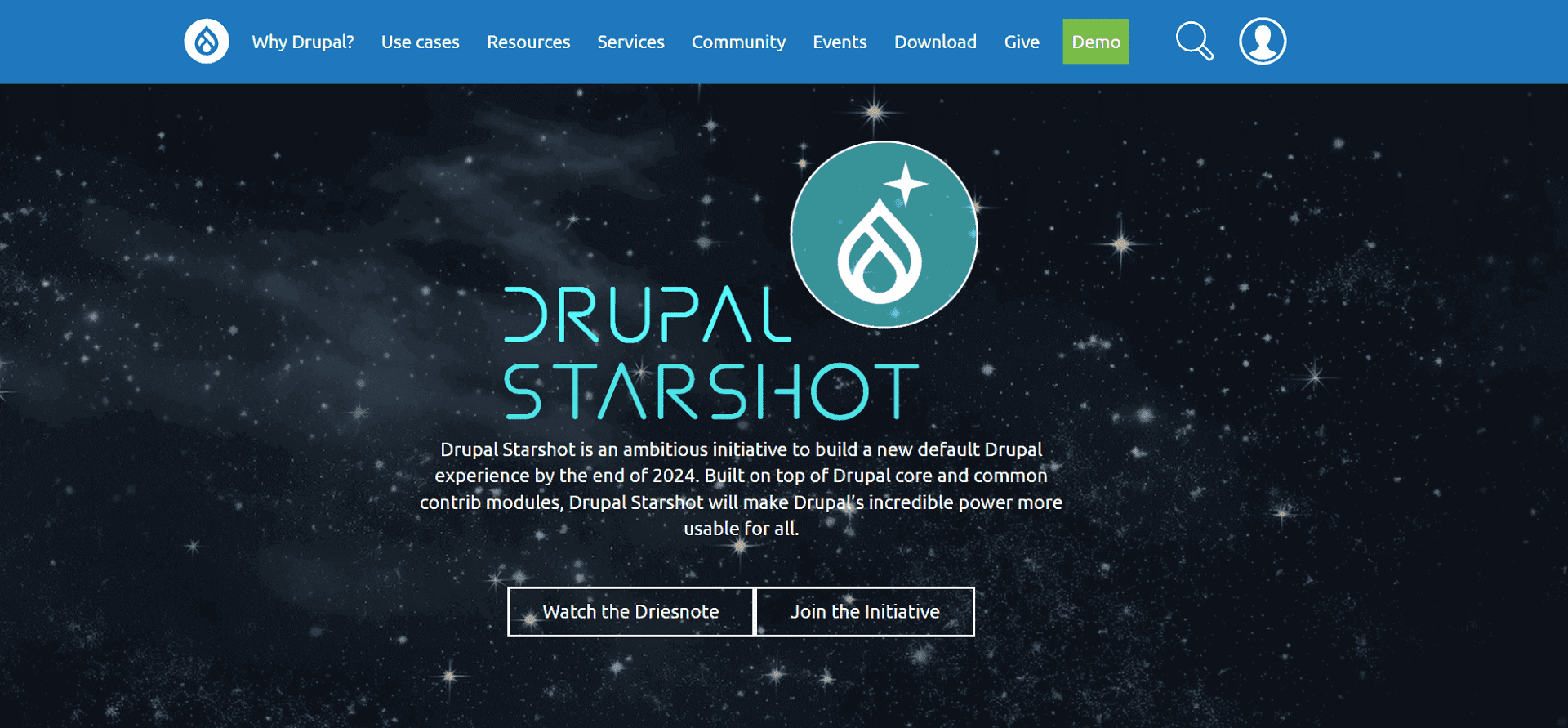
Key Features of Drupal:
- Extensive library of modules (plugins) and themes: This allows for high customization and functionality tailored to specific site needs.
- Highly scalable for complex content structures: Drupal excels in managing detailed and densely structured content, making it ideal for large-scale and complex sites.
- Strong emphasis on security with regular updates driven by the community: Continuous improvements and updates ensure that Drupal remains secure against potential vulnerabilities.
Pros:
- Highly customizable: The modular system and numerous customization options make it possible to build virtually any type of website.
- Suitable for complex, large-scale projects: Drupal’s robust framework is capable of handling extensive content needs and high traffic volumes without sacrificing performance.
Cons:
- Steep learning curve: Drupal’s advanced features come with a complexity that might be challenging for beginners or those with limited technical skills.
- Requires ongoing maintenance: Being a self-hosted solution, maintaining a Drupal site involves manual updates and security management, which can be resource-intensive.
Pricing:
Free and open-source with associated costs (like hosting, domain, development, etc.)
Duda and Drupal offer distinct approaches tailored to different user needs. While Duda provides efficiency and client management tools ideal for web design agencies and freelancers, Drupal offers unparalleled depth and flexibility for managing complex websites with extensive content requirements. Each platform fills a unique niche in the website building landscape, expanding the horizons beyond traditional options like WordPress.
7. HubSpot
HubSpot is a comprehensive inbound marketing, sales, and CRM suite that has expanded its offerings to include a CMS (Content Management System). My firsthand experience with HubSpot revealed how seamlessly it integrates various aspects of digital marketing, offering a cohesive platform to manage a range of website and marketing functions.
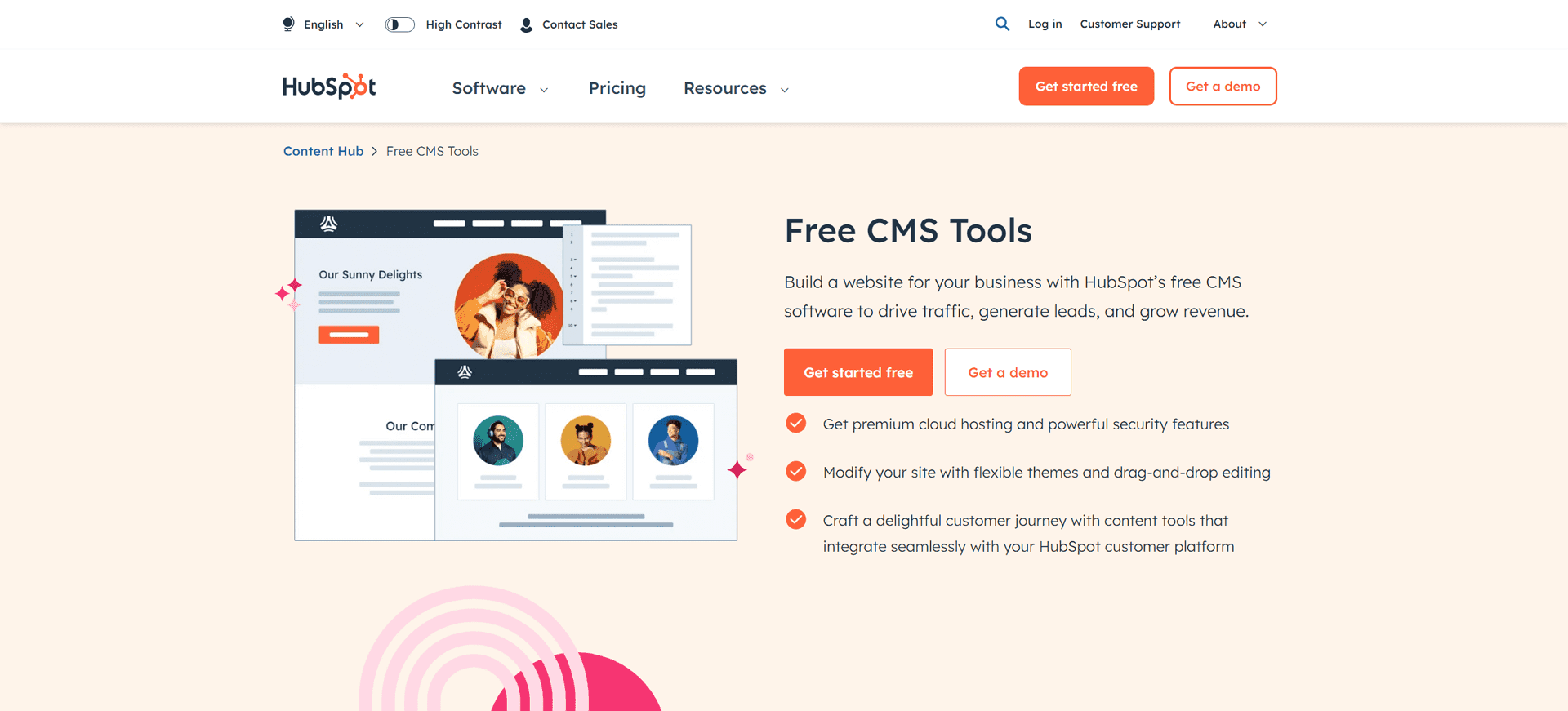
Key Features of HubSpot:
- Seamless integration of marketing and CRM infrastructure: HubSpot's CMS is tightly woven into its CRM, facilitating personalized user experiences and data-informed marketing strategies.
- Built-in SEO and marketing attribution tools: These tools simplify the process of optimizing content for search engines and tracking the effectiveness of marketing initiatives.
- Robust security features, including a global CDN and Web Application Firewall: Ensures that websites built with HubSpot are secure and performant at a global scale.
- Powerful connected analytics: Provides deep insights into website performance and user behavior, enabling data-driven decision-making.
Pros:
- All-in-one platform: HubSpot offers a range of tools that encompass nearly every aspect of online business, from sales to marketing to service.
- Ease of use: While offering a breadth of features, HubSpot remains user-friendly even for those without technical expertise.
Cons:
- May be overkill for simple websites: Small websites without the need for complex marketing campaigns might find the feature set and price point too excessive.
- Limited design options compared to specialized CMSs: Although it offers versatility, HubSpot's design flexibility may fall short for those looking for highly customized solutions.
Pricing:
HubSpot’s CMS is now part of HubSpot Content Hub. Its basic CMS features are free to use. Content Hub’s paid plan starts at $450/month (includes 3 seats).
8. Ghost
Ghost is an open-source blogging platform that distinguishes itself with a focus on professional publishing, monetization, and simplicity. Throughout my use of Ghost, what stood out was its minimalistic editor and strong emphasis on content and SEO, providing a clean and efficient user experience for blogging and content-centric websites.
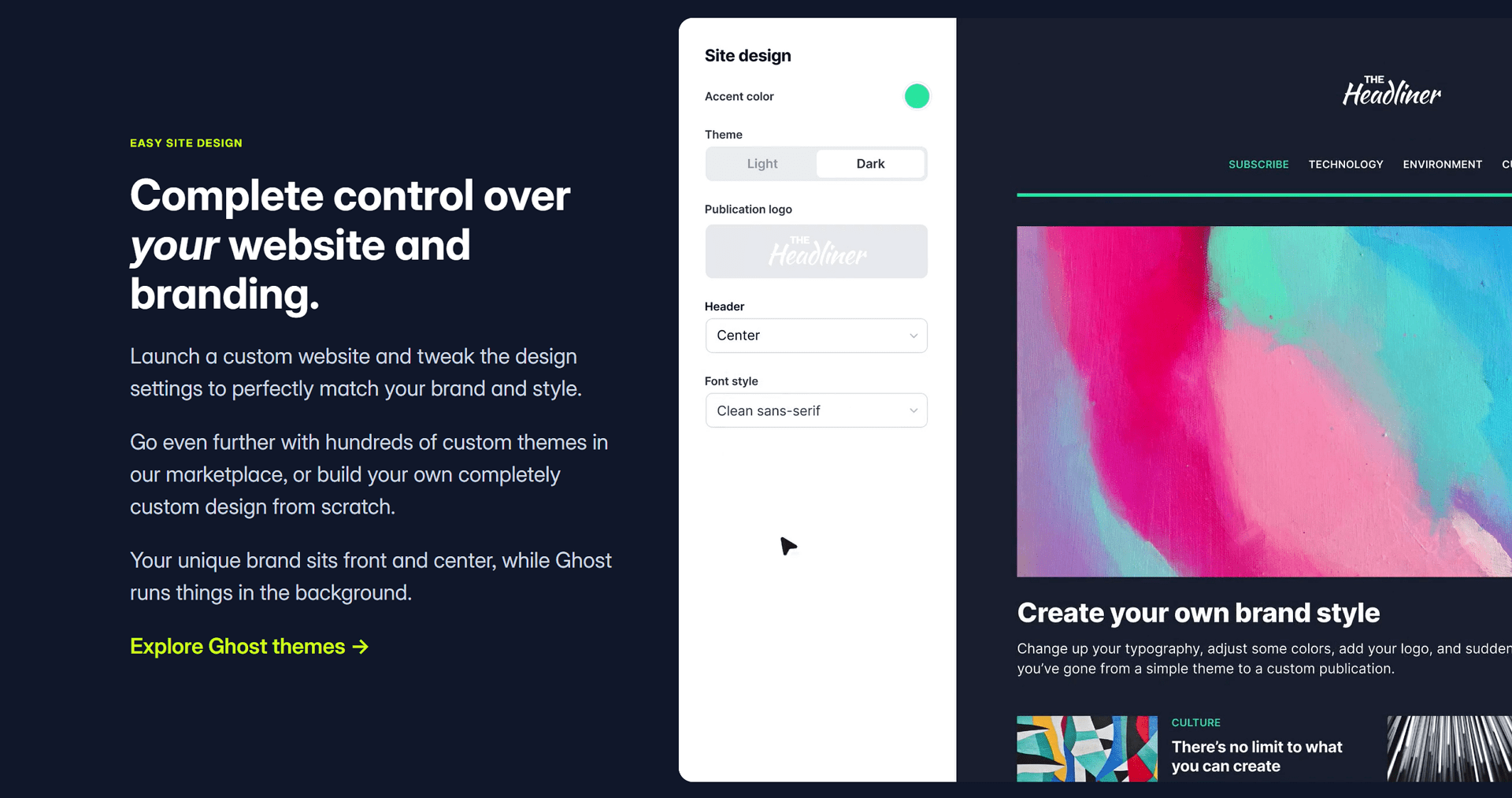
Key Features of Ghost:
- Content editor using cards, akin to WordPress blocks: Allows for a flexible layout of text, images, and other media within posts.
- Excellent support for SEO: The platform is designed with built-in SEO tools to enhance content visibility.
- Monetization tools for paid online journals or content hubs: Ghost includes subscription and payment features, simplifying the process of creating membership-based content.
Pros:
- Focused on content: Ghost is streamlined for writers and publishers, making it an ideal choice for online publications and blogs.
- Speed and performance: Due to its lightweight design, websites built with Ghost typically enjoy quick load times which contribute positively to user experience and SEO.
Cons:
- Less versatile than other CMS platforms: Ghost is optimized for blogging and may not be as well-suited for complex website builds outside of content publishing.
- Limited themes and integrations: While the available themes are high-quality, the selection is not as extensive as other, more established CMS options.
Pricing:
Ghost offers a starter package of $9/mo. while its business hosting services start at $199/mo. when billed annually.
HubSpot and Ghost cater to different end-goals in the website management ecosystem. HubSpot serves businesses looking for a robust, all-encompassing platform to integrate their website with marketing, sales, and CRM, whereas Ghost provides a sleek solution for writers, publishers, and content creators who focus mostly on blogging and content distribution, with an easy path to monetize their work. Each has carved out a niche that demonstrates the expansive scope of solutions available outside the realm of WordPress.
9. Medium
Medium is more than just a content management platform; it is also a social journalism site with a heavy focus on the content reading experience. For writers, publishers, and companies looking to reach an existing audience with less effort in building one from scratch, Medium offers a compelling platform. My experience with Medium has been notable for its simplicity in publishing and the potential visibility it offers content creators within its vast reader community.
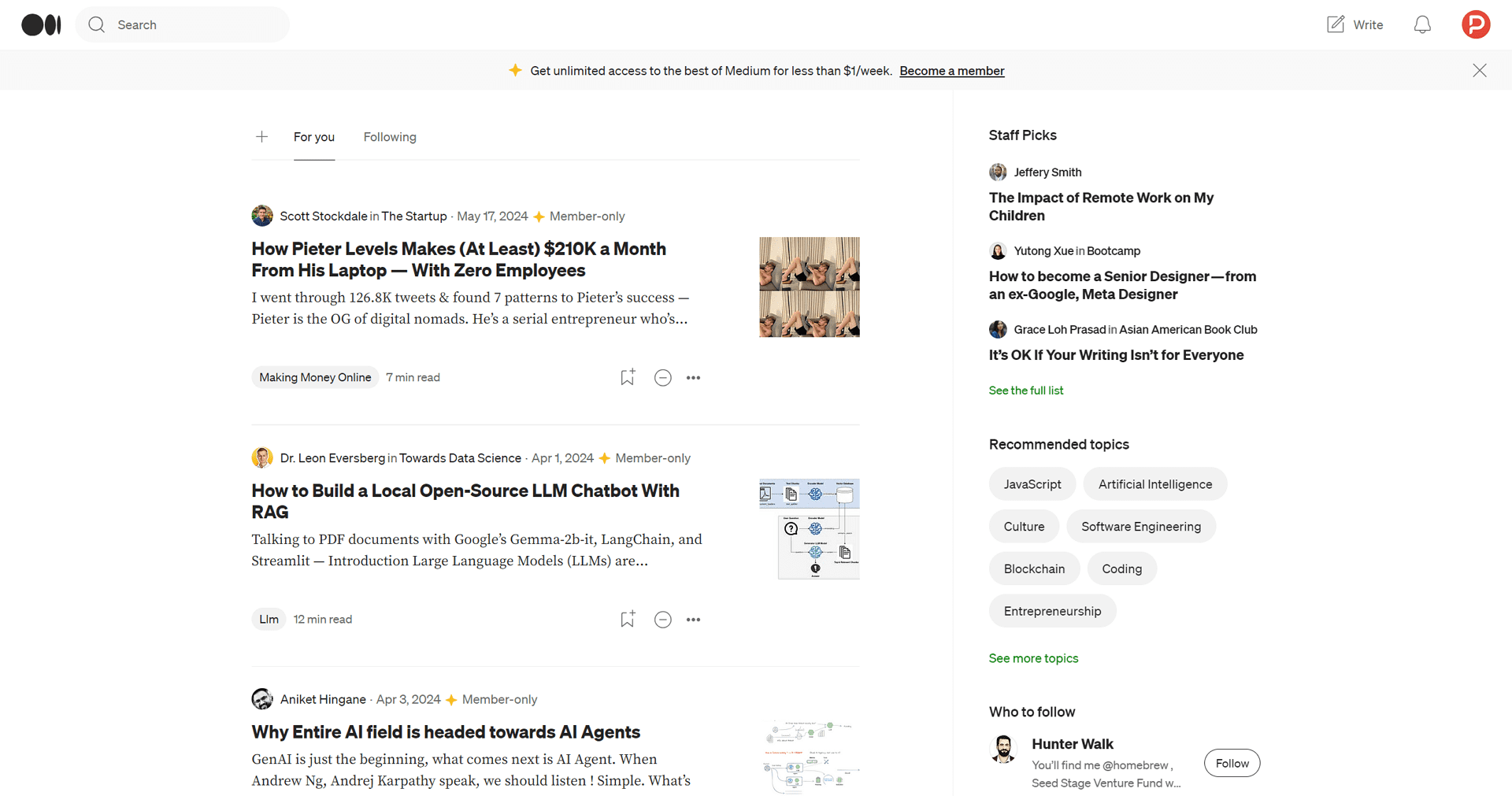
Key Features of Medium:
- Attractive content editor that is very minimalistic: Ensures a clean, distraction-free environment for both writing and reading.
- Option to publish within the Medium ecosystem for greater exposure: Content can benefit from Medium's large, built-in audience, with the option for authors to use custom domains.
- A unique approach to commenting, which happens inline: Comments can be made directly on paragraphs, facilitating targeted discussions.
Pros:
- Ease of use: No setup is required, and the platform can be used immediately upon signing up.
- Potential for high exposure: Content can reach a wide audience quickly, thanks to Medium's recommendation algorithms and community.
Cons:
- Limited control over design and branding: The uniformity of Medium's design limits how much authors can make their pages stand out.
- Potential challenges in monetizing content: While Medium has a partner program, control over monetization strategies is limited compared to running your own site.
Pricing:
Free
10. Google Sites
Google Sites is a structured wiki- and web page-creation tool offered by Google. This platform allows for the easy creation of websites using a drag-and-drop editor, with seamless integration into Google's ecosystem. My utilization of Google Sites has demonstrated its effectiveness for building simple websites and intranets, particularly benefiting from its integration with tools like Google Drive, Docs, and more.
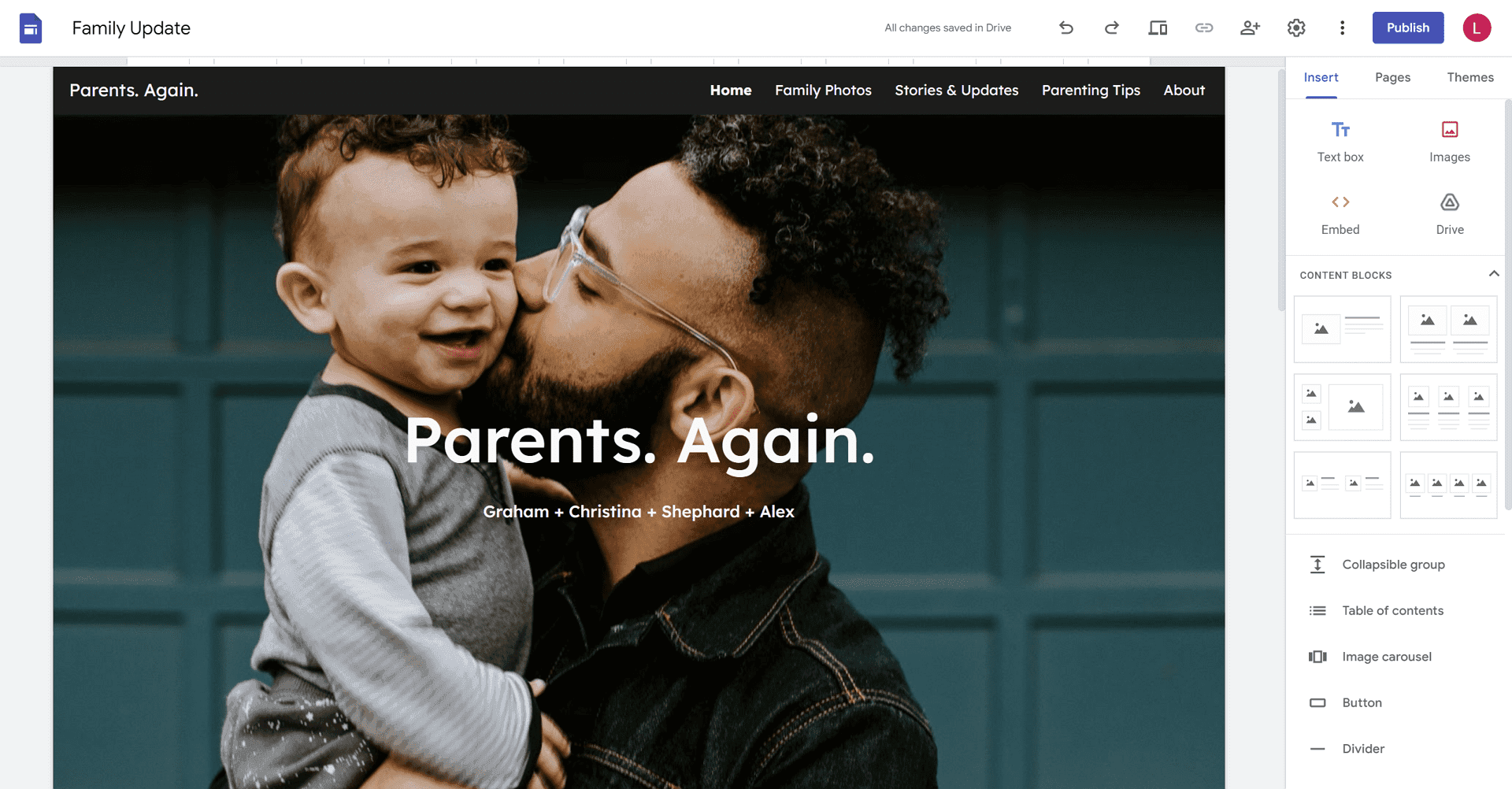
Key Features of Google Sites:
- Seamless integration with Google’s ecosystem: Easily embed documents, spreadsheets, and presentations from Google Drive.
- Intuitive drag-and-drop editor: Simplifies the web design process, allowing users to build sites without any coding knowledge.
- Pre-designed templates for quick building: Users can start with ready-made templates, making site creation faster and more straightforward.
Pros:
- Ease of use: Google Sites is notably user-friendly, making it accessible for people with limited technical skills.
- Free to use: Accessible with any Google Account at no additional cost, making it an excellent choice for personal, educational, or small project uses.
Cons:
- Limited design and customization options: Compared to more advanced website builders, Google Sites offers fewer customization opportunities.
- May not scale well for larger, more complex websites: While great for simple sites, its features may be too basic for those requiring more advanced functionality.
Pricing:
Free to use with a Google Account
Medium and Google Sites approach content creation and website building from different perspectives but are aligned in their principle of accessibility. Medium focuses on writers and content creators looking to engage with an existing audience, prioritizing the reading and writing experience. In contrast, Google Sites offers a straightforward, no-cost solution for creating simple websites, leveraging Google's suite of productivity tools for an integrated experience. Both platforms illustrate the varying needs of online content creators, from individual blogging to creating informational websites.
Comparison Table: Best WordPress Alternatives in a Nutshell
Here's a comparison table summarizing the key features, pros, cons, and pricing of each CMS alternative:
Platform | Key Features | Pros | Cons | Pricing |
| Shopify | Exclusively for eCommerce, Hosted platform, Extendable with themes and apps | User-friendly, Comprehensive tools | Transaction fees, Limited customization without coding | Starts at $25/mo + transaction fees |
| Wix | Fully-hosted, Extensive collection of templates, Drag-and-drop customization | Ease of use, Flexibility in design | SEO limitations, Difficulty switching templates | Starting at $17/mo |
| Squarespace | All-in-one solution, Over 100 templates, Built-in SEO and marketing tools | Ease of use, High-quality design | Limited customization options, Higher price point | Starting at $16/mo |
| Webflow | All-in-one SaaS platform, Beginner-friendly visual site builder, Custom CMS builder | Unparalleled design flexibility, No-code logic and interactions | Steep learning curve, Pricing can be confusing | Free to build, starting at $14/mo for paid plans |
| Duda | Intuitive drag-and-drop interface, Agency plans (Whitelabeling), Built-in templates | Optimized for speed and efficiency, Client management features | Limited e-commerce, Higher cost for full features | Plans start at $19/mo |
| Drupal | Extensive modules and themes, Highly scalable, Strong emphasis on security | Highly customizable, Suitable for complex, large-scale projects | Steep learning curve, Requires maintenance | Free, with associated costs |
| HubSpot | Integration with CRM, Built-in SEO and analytics, Robust security features | All-in-one platform, Ease of use | Overkill for simple sites, Limited design options | Content Hub’s paid plan starts at $450/month. |
| Ghost | Content editor using cards, SEO support, Monetization tools | Focused on content, Speed and performance | Less versatile, Limited themes and integrations | Starter is $9/mo, Business from $199/mo billed annually |
| Medium | Minimalistic content editor, Publish in Medium ecosystem, Inline commenting | Ease of use, Potential for high exposure | Limited control over design, Monetization challenges | Free |
| Google Sites | Integration with Google, Drag-and-drop editor, Pre-designed templates | User-friendly, Free to use | Limited design options, May not scale well | Free with a Google Account |
This table concisely summarizes the platforms' features, benefits, and potential drawbacks and includes pricing information for quick comparison.
Conclusion
while there are numerous content management systems and platforms available, choosing the right one depends on your specific needs, technical skills, and the goals you aim to achieve with your website or blog.
Each tool brings unique strengths to the table, whether it’s marketing integration, content focus, built-in audiences, or cost-efficiency. Assess the key features, pros, cons, and pricing laid out in this analysis to identify the CMS or platform that best aligns with your vision, resources, and content creation aspirations. Your perfect choice is out there; it's all about matching your requirements to the offerings of each of these capable platforms.
FAQs
Q: What is a website building platform?
A: A website building platform is an online tool or software service that allows individuals and businesses to create, design, and manage their websites without needing to code from scratch. These platforms provide a range of templates, drag-and-drop editors, and customizable features to accommodate various types of web designs and functionalities.
Q: How do I choose the best website building platform for my needs?
A: To choose the best website building platform for your needs, consider factors such as ease of use, design flexibility, e-commerce capabilities, pricing, and specific features that match your business requirements. It's also important to consider the platform's SEO tools and the level of customer support provided.
Q: Can I use a website building platform if I have no coding experience?
A: Yes, most website building platforms are designed with non-technical users in mind, offering drag-and-drop interfaces, pre-designed templates, and visual editing tools that allow you to create a website without any coding experience.
Q: Are website building platforms suitable for e-commerce sites?
A: Many website building platforms are equipped with e-commerce features and tools, making them suitable for creating online stores. Look for platforms that offer shopping cart integration, payment processing options, and inventory management to ensure they can handle your e-commerce needs.
Q: Will my website be mobile-friendly if I use a website building platform?
A: Most website building platforms offer responsive design templates, which means your website will automatically adjust to look good on various devices, including desktops, tablets, and smartphones. Always check if the platform offers mobile-responsive options to ensure the best user experience.
Q: Can I use my own domain name with a website building platform?
A: Yes, the majority of website building platforms allow you to use your own domain name. Some platforms include a free domain name for the first year with their plans, while others may require you to purchase your domain separately and connect it to your website.

